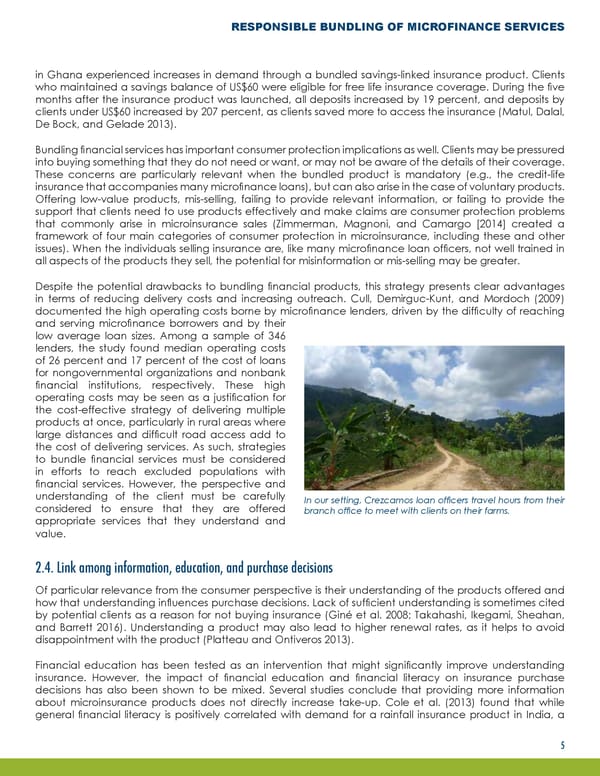RESPONSIBLE BUNDLING OF MICROFINANCE SERVICES in Ghana experienced increases in demand through a bundled savings-linked insurance product. Clients who maintained a savings balance of US$60 were eligible for free life insurance coverage. During the five months after the insurance product was launched, all deposits increased by 19 percent, and deposits by clients under US$60 increased by 207 percent, as clients saved more to access the insurance (Matul, Dalal, De Bock, and Gelade 2013). Bundling financial services has important consumer protection implications as well. Clients may be pressured into buying something that they do not need or want, or may not be aware of the details of their coverage. These concerns are particularly relevant when the bundled product is mandatory (e.g., the credit-life insurance that accompanies many microfinance loans), but can also arise in the case of voluntary products. Offering low-value products, mis-selling, failing to provide relevant information, or failing to provide the support that clients need to use products effectively and make claims are consumer protection problems that commonly arise in microinsurance sales (Zimmerman, Magnoni, and Camargo [2014] created a framework of four main categories of consumer protection in microinsurance, including these and other issues). When the individuals selling insurance are, like many microfinance loan officers, not well trained in all aspects of the products they sell, the potential for misinformation or mis-selling may be greater. Despite the potential drawbacks to bundling financial products, this strategy presents clear advantages in terms of reducing delivery costs and increasing outreach. Cull, Demirguc-Kunt, and Mordoch (2009) documented the high operating costs borne by microfinance lenders, driven by the difficulty of reaching and serving microfinance borrowers and by their low average loan sizes. Among a sample of 346 lenders, the study found median operating costs of 26 percent and 17 percent of the cost of loans for nongovernmental organizations and nonbank financial institutions, respectively. These high operating costs may be seen as a justification for the cost-effective strategy of delivering multiple products at once, particularly in rural areas where large distances and difficult road access add to the cost of delivering services. As such, strategies to bundle financial services must be considered in efforts to reach excluded populations with financial services. However, the perspective and understanding of the client must be carefully In our setting, Crezcamos loan officers travel hours from their considered to ensure that they are offered branch office to meet with clients on their farms. appropriate services that they understand and value. 2.4. Link among information, education, and purchase decisions Of particular relevance from the consumer perspective is their understanding of the products offered and how that understanding influences purchase decisions. Lack of sufficient understanding is sometimes cited by potential clients as a reason for not buying insurance (Giné et al. 2008; Takahashi, Ikegami, Sheahan, and Barrett 2016). Understanding a product may also lead to higher renewal rates, as it helps to avoid disappointment with the product (Platteau and Ontiveros 2013). Financial education has been tested as an intervention that might significantly improve understanding insurance. However, the impact of financial education and financial literacy on insurance purchase decisions has also been shown to be mixed. Several studies conclude that providing more information about microinsurance products does not directly increase take-up. Cole et al. (2013) found that while general financial literacy is positively correlated with demand for a rainfall insurance product in India, a 5
 Responsible Bundling of Microfinance Services Page 7 Page 9
Responsible Bundling of Microfinance Services Page 7 Page 9